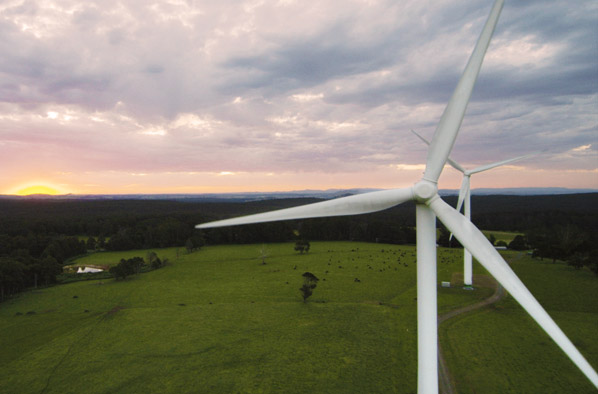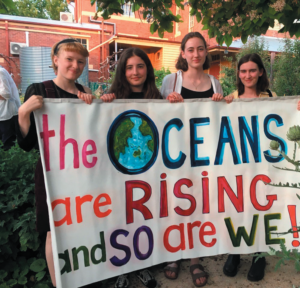We need to master the art of asking questions which address the gravity of our situation, yet which also create longing, which evoke a deep and rich sense of the wonders we can still create, rather than shutting it down or putting it into a deep sleep of complacency.
Rob Hopkins: From What Is to What If, Chelsea Green Publishing, 2019, p.126
From farmers markets and consumer-producer co-operatives to local business alliances and community finance schemes, people are reweaving the fabric of local interdependence from the ground up. Out of common sense and heartfelt intuition, they are finding innovative ways to step out of the consumer rat race to live local lives at a human pace and scale.
Helena Norberg-Hodge, Founder – Local Futures
Welcome to our October/November newsletter. In this edition you can read about:
- Castlemaine Free University– two November events
- Mollongghip Poetry Slam
- Castlemaine Seed Library– Working Bee
- Newstead Arts Hub– Art Auction
- Free Firewood in Hepburn Shire
- Walking Together -Towards Reconciliation
- Restoring landscapes in a changing climate
- Repair Cafes
- West End Resilience and Community Energy
- Deliberative Engagement
- Gather- Castlemaine Commons and a Solidarity Network
- Benefit Concert for Central Vic Wildlife Hospital
- New Economy Network Conference
- Local Law for Weed Control in Mount Alexander Shire
- New hope in central Victoria for endangered Eltham Copper Butterfly
- New name for local creek
- Bird of the month– Kestrel
- Building anti-gold mining campaigns
- New Community Visions & Council Plans
- Saltgrass Podcast award
- Free Green Waste disposal
- New Hepburn Shire local laws/guidelines for salvaging, firewood collection & nature strip planting
- Orchard Keepers– CSA now open
- New Edition- Wildlife of the Box Ironbark Country
- The Wombat Post
- Hepburn Wind- Heat Pump Bulk-buy
- Healthy Landscapes Guide
- Wararack Initiatives
- Resourceful Hepburn
- Common Times
- A new species for the Wombat Forest
- Food for Thought
1. Castlemaine Free University – Two November events
1.1 What: Impact producing with Alex Kelly
When: Monday November 1st, 7-9pm
Where: Northern Arts Hotel, 359 Barker St, Castlemaine
A free event
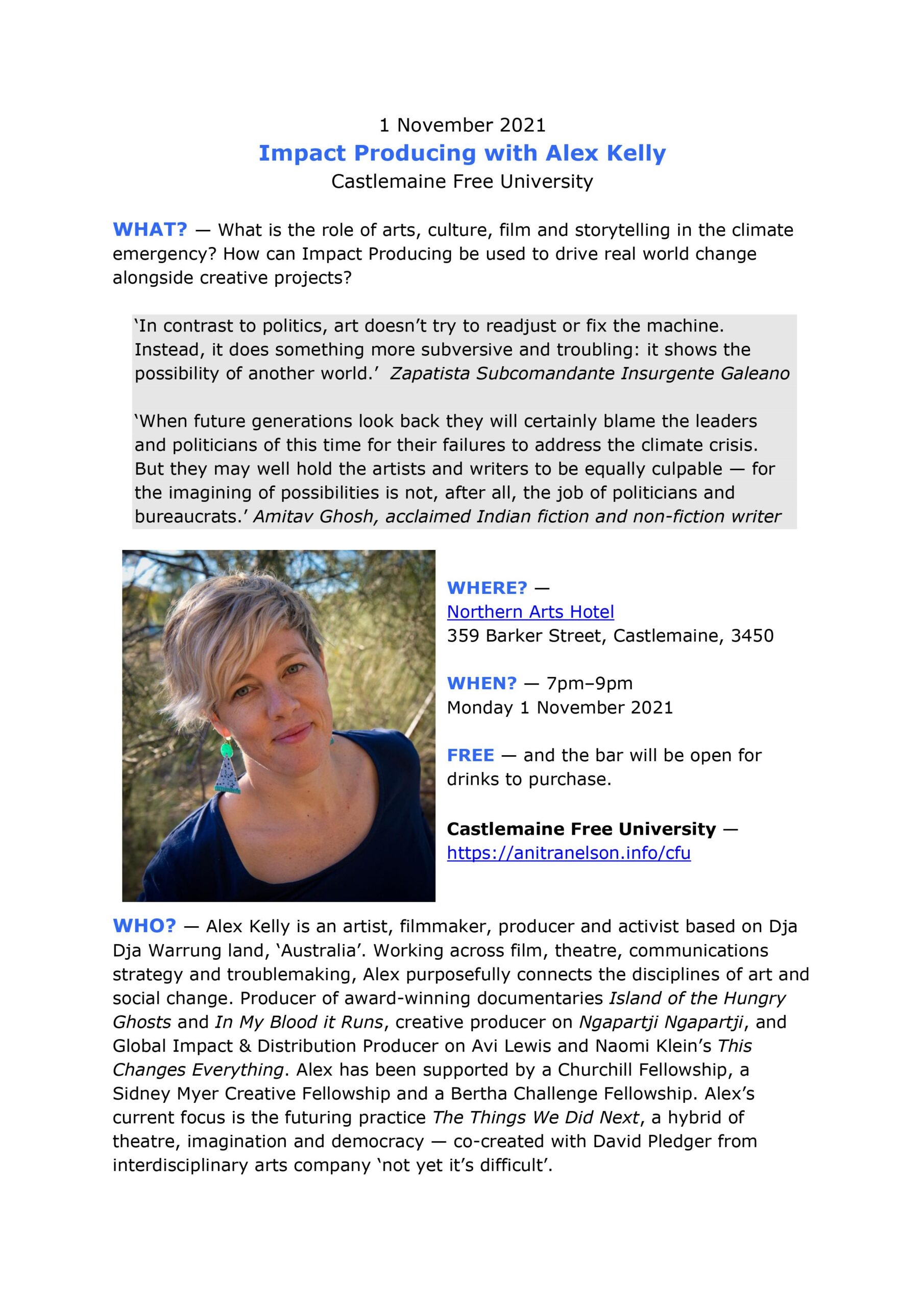
1.2 What: History of music in Jamaica and the Caribbean — including Cuba
The Loudest Island in the World: From First Nations to Reggae
When: Sunday afternoon 14 November 2021, 2–6pm, with breaks!
Where: Northern Arts Hotel, 359 Barker St, Castlemaine
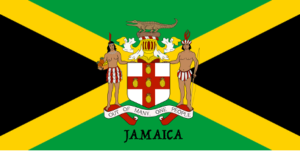
WHAT? — Once again, Ralph Newmark on the history of music in Jamaica and the Caribbean — including Cuba. Experience and understand political, economic, cultural, and social change in the region. Enjoy ‘history through music’ and participate in the Q&A
WHO? — Honorary Fellow, University of Melbourne (Spanish and Latin American Studies, School of Languages and Linguistics) Dr Ralph Newmark is an historian, past Director Institute of Latin American Studies, La Trobe University(ILAS, 2008–2020), a media regular, discussing Latin American affairs, and presenter of a 3CR radio program on the history and music of Latin America and the Caribbean.
2. Mollingghip Poetry Slam
When: Saturday November 13th, 7.30pm, via zoom
Note: Email Mark for a personal invite- see contact details below
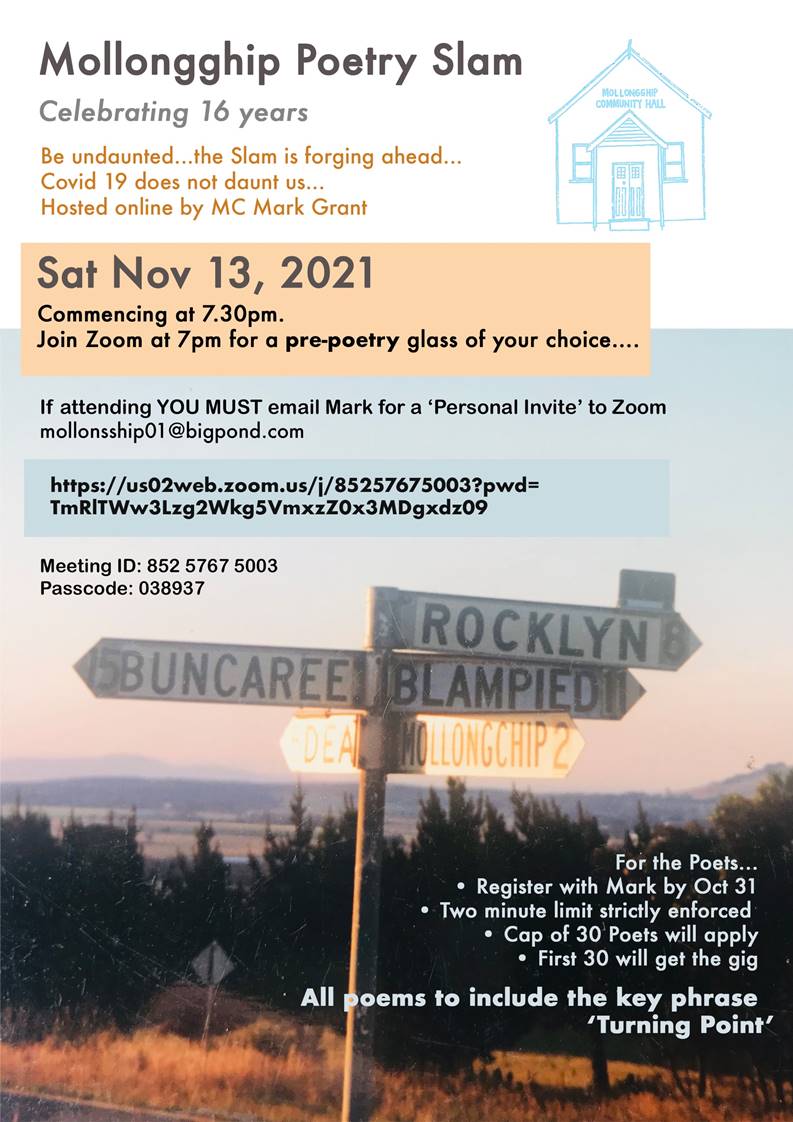
Photo credit- Gib Wettenhall
3. Castlemaine Seed Library

Next Working Bee: Thursday 4th November, 11am at Castlemaine Library- in person. All are welcome at these friendly seed-packing sessions.

This month on the board you will find sunflower seeds, flat leaf parsley, dill, celery, cucumber, red climbing Malabar spinach, Speckled Cranberry bean, big yellow tomato ( Easy to germinate, abundant and tasty! Originally donated by Newstead Community garden), garlic chives, Russian Kale, parsnip, Red Cos lettuce, Periforme Abruzzese tomato (perfect for pasta sauce!), Wasabi mustard, Daikon radish, rocket, mixed lettuce, Rainbow chard and Japanese pumpkin, and Golden Bantem corn.
Also flower display with sunflower seeds, and mixed flowering annuals seeds.
Malabar spinach is a frost tender perennial vine. Plants are vigorous climbers. Leaves taste and resemble true spinach in appearance and are used as a substitute. They are used both as a salad green and as a leaf vegetable. Plants grow very quickly in warmer climates. Used to thicken soups and stews. Keep well watered. Pick leaves as required. Plants do best when grown on a trellis.
For more information go to: https://www.facebook.com/castlemaineseedlibrary/
4. Newstead Arts Hub- Art Auction
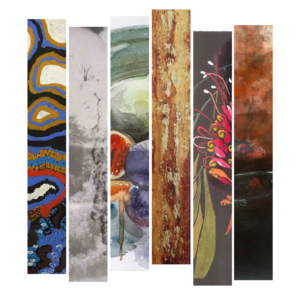
The annual Art Auction brings together our favourite interests – arts, community and events. Our small community Arts Hub works hard to provide exhibitions, workshops and events to our local community at affordable and accessible prices – but to do this we need funding. Each year an auction is held to raise the funds necessary to keep the Hub doors open and community arts alive in our beautiful country town.
Celebrating the arrival of warmer weather, the evening is moving outdoors for a live auction in front of the sunset. The event will be held on Saturday 27 November, from 5.30pm, concluding around 8.30pm. All of the art to be auctioned can be viewed on our website, or previewed on the morning of the auction from 10am-12pm. Or you can wander the gallery while enjoying a glass of wine just before the auction starts. Pick your favourite works ahead of the event!
We have a beautiful collection of works available for your bids, all donated by the wonderful artists, collectors and galleries that make our arts community so strong. With work from well known artists as well as local and talented treasures, there is a bounty of work to bid for.
Book your tickets now through our website. Art and tickets can be found at https://newsteadartshub.org/portfolio/artauction/
5. Free Firewood in Hepburn Shire
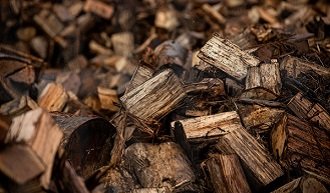
As a result of the storms and the ongoing works, there is a large supply of roughly split firewood that is available immediately to be delivered free of charge to community groups across Hepburn Shire. We are putting a call out to community and sporting groups in Hepburn Shire who have the capacity to receive a truck load of firewood (approx. 9-10m3). This wood can then be utilised by your group and individual members.
The firewood will be delivered in a tipper truck (20 tonne fully loaded) to a single nominated address. The truck will need safe access on and off the property. This freshly cut timber is green and will need 12-18 months to season before it is ready to burn. The timber will require some further splitting prior to use. Before taking this timber you should consider if your community group has the capability to do this.
Hepburn Shire Council is also keen for community and sporting groups to accept additional firewood to further split and deliver to vulnerable people across our community as part of your voluntary outreach. This potential partnership between Council and community groups would greatly benefit community members with limited capacity to take advantage of the free firewood program Council is running out of the transfer stations.
Residents and ratepayers can book a time to collect their two cubic metres (2m3) of cut and split firewood.
Book now using the following links:
Trentham
Creswick
Daylesford
More booking times and sessions will open throughout November and December.
For terms and conditions visit our website. We look forward to seeing you with your trailer or ute!
For further information contact: Ryan Turner rturner@hepburn.vic.gov.au 0477 970 828; Inga Hamilton ihamilton@hepburn.vic.gov.au 0456 950 924
6. WALKING TOGETHER – towards Reconciliation
ABORIGINAL LANGUAGE AND CULTURE by Solway Nutting for Nalderun Education Aboriginal Corporation
We human beings communicate in many ways, with words, body language, art, music and dance, and there can also be a deep connection beyond words, when we experience something wonderful together. Those who can’t make themselves understood or share their meanings are often left aside. For Aboriginal and Torres Strait Islander people, being able to speak in language has a deep connection to their cultural identity. There are teachings in language for which there is no English equivalent. Language is essential for passing on cultural knowledge, kinship, songlines and stories from generation to generation.
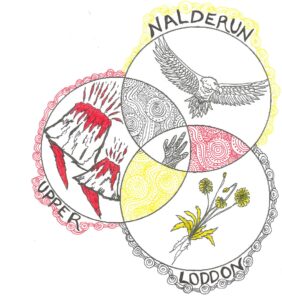
Whilst cultural practices and beliefs may change and evolve, many of the basic aspects remain the same. When people are disconnected from their culture, as has happened since colonisation, it has a deep impact on their sense of identity and belonging. This loss and damage takes away their sense of meaning and purpose. The importance of language and culture to First Nations Australians is one of the 16 socio-economic targets of the new National Agreement on Closing the Gap, a target relating to the number and strength of Aboriginal and Torres Strait Islander languages.
Up to 160 languages are still in use, many critically endangered. At least 30 languages are being reawakened by communities in Australia; nine Swinburne University students have recently qualified as teachers of endangered languages Woi Wurrung, Wada Wurrung, Gunai/Kurnai, Wergaia and Peek Wooroong, in schools, kindergartens and Aboriginal communities. Only about 8% of Aboriginal and Torres Strait Islander children speak an Australian Indigenous language at home. Currently no more than twelve traditional languages and two of the new ones are considered strong.
Land, family, law, ceremony and language are elements that play a crucial role in shaping all our lives, regardless of our culture or heritage. These five elements are intricately interconnected in Indigenous culture. Many Indigenous people have a unique view of the world that’s distinct from the mainstream. The sacred is not separate from the secular: people, plants and animals, landforms, wind, fire, and celestial bodies are part of a larger reality. Everything is alive; each being is energised by a spirit. According to the Creation Stories, the ancestral spirits made rules and created the lore to govern the land, the waterways, and their people, animal and plant life.
This is a general description, not specific to any particular nation as all are different, and there are differences even within any language group.

The relationship between Indigenous people and the land, or Country as mob call it, is one of reciprocity and respect – the land sustains and provides for the people, and the people sustain and manage the land through culture and ceremony. Honouring this reciprocal relationship with the land is central to Indigenous culture. If the land is disrespected, damaged or destroyed, it can have real impact on the wellbeing of the people.
Families are connected to Country through the kinship system, and this connection to land comes with specific roles and responsibilities, which are enshrined in the lore/law and observed through ceremony.A person’s position in the kinship system establishes their relationship to others and to the universe, prescribing their responsibilities towards other people, the land and natural resources. Traditional kinship structures remain important in many Indigenous communities today. There are three levels of kinship: Moiety, Totem and Skin Name. In Moiety systems, people and the environment are split into two halves, which mirror each other. To understand the whole universe these two halves must come together.
Each person has at least four Totems, representing their nation, clan and family group, as well as a personal Totem. The Skin Name indicates a person’s bloodline, conveying information about how generations are linked and how they should interact. Within the First Australian nations, there are clan groups, and within the clan groups there are family groups. Family means extended family – parents, several children, numerous aunts, uncles and cousins, and grandparents. For example, mother applies to the biological mother and to her sisters. A person would be expected to show respect to their fathers, mothers, aunts and uncles, and would claim respect from their sons, daughters, nieces and nephews. Some individuals and families protect particular knowledge, such as specific dances and songs, while others protect other types of knowledge, such as body design or symbolism, or are guardians of sacred sites. These guardians hold great religious and spiritual power within a language group, and conduct ceremonies accordingly.
The Dreaming refers to the complexity of Aboriginal cultural, spiritual and religious beliefs, practices and lore. Ceremonies ensure that vital components of the lore and The Dreaming stay intact. They provide a time and place where all people in a language group and community work together to maintain and ensure the ongoing survival of cultural beliefs. Recovering language, which could bring with it traditional ceremony, lore/law, respect for sacred sites and ancestral country, may be the key to restoring dignity, identity and purpose to First Nations people. When other Australians learn more about their culture, it will help lead to healing for both First and Second Nations.
Nalderun is a service that supports the Aboriginal Community, led by Aboriginal people. Many people and organisations in the Mount Alexander Shire contribute to Nalderun; the name is a Dja Dja Wurrung word meaning “all together”. More information can be found at www.nalderun.net.au
7. Restoring landscapes in a changing climate
What: Connecting Country’s Future-Proof our forests and AGM
When: Saturday 13 November 2021, 2-3.30pm via zoom
Bookings are essential for this online event. To make a booking – click here
How do we plan for restoring and revegetating our fragmented habitat, in a time of climate change? What are the latest projections for our climate over the coming decades and how does this affect revegetation projects? Connecting Country are hosting an online event exploring this topic, combined with our Annual General Meeting (AGM) on Saturday 13 November 2021 at 2.00 pm. This year’s AGM theme is ‘Restoring landscapes in a changing climate’ and Connecting Country has secured two guest speakers who will explore climate change projections for our region and how revegetation projects might look in the future.
Guest speakers at the event will be Bonnie Humphreys (Connecting Country) and Geoff Caine (Department of Environment, Land, Water and Planning). Bonnie will update the audience about Connecting Country’s mission to create two climate future plots in our region, with support from the Ross Trust. Bonnie is Connecting Country’s Landscape Restoration Coordinator and coordinates on-ground actions and ecological surveys. Geoff will be speaking on the latest climate projections for our region and the implications for biodiversity and revegetation. Geoff is a Program Manager (Community and Partnerships) at DELWP, focusing on climate change, energy and sustainability.
Landcarers and landholders in the Mount Alexander region are increasingly concerned about the future viability of their revegetation work, given recent weather patterns and future climate predictions. Many have seen their revegetation plantings die in recent years due to heat and water stress, and some have even stopped planting.
Connecting Country seeks to help address this issue and has secured funding through the Ross Trust to establish two climate future plots of 500 plants right here in Mount Alexander region during 2021-23. This ‘Future-proof our forests’ project focuses on two important species from our local area: Silver Banksia (Banksia marginata) and Sweet Bursaria (Bursaria spinosa).
You may have heard the terms ‘climate future plot‘, ‘climate-resilient landscapes‘ or ‘climate-ready revegetation‘, but what do they actually mean? In simple terms, they refer to the use of climate change modelling to plan for revegetation, by using suitable indigenous plants sourced from places with climates similar to that predicted at the revegetation site in decades to come (usually hotter and drier places). This is a new and emerging revegetation technique.
Bonnie Humphreys (Connecting Country) will talk about how climate future plots work and the challenges of pioneering our first local plots. ‘We are working to include a variety of plant provenances, grown from seed from areas that are hotter and drier, as well as areas that are cooler and wetter’. ‘Even though our climate is predicted to become hotter and drier, there may be other genetic information stored within a particular provenance, such as ability to survive an insect attack, or frost resilience, which plants from the hotter and drier area do not have,’ said Ms Humphreys.
The project has selected plant provenances based on Bureau of Meteorology’s climate predictions for our region. These are paired to these predictions with species distribution and the availability of seed for our chosen plants. Connecting Country hopes the climate future plots will create seed production areas and provide climate-adapted seed for use in future revegetation projects. They will also help to identify individuals and provenances most suited to survive in our changing climatic conditions.
The AGM will include a brief presentation from staff and committee members about Connecting Country’s achievements over the past year, to allow supporters old and new to hear what Connecting Country does and plans for the coming year. All are welcome. For further information: ivan@connectingcountry.org.au or call (03) 5472 1594.
Posted on 21 October, 2021 by Connecting Country: https://connectingcountry.org.au
8. Repair Cafes
With covid restrictions lifting and moves towards opening up, our local repair cafes are planning to be back into the swing during November. Here’s some details:
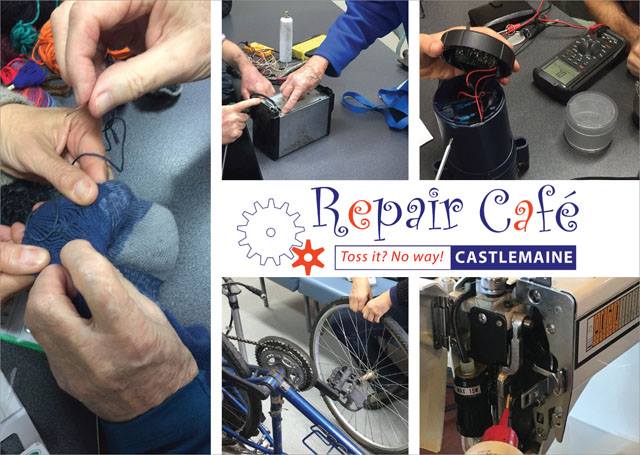
Daylesford Repair Cafe
When and Where: Sunday November 21st, 1-4pm at Victoria park Pavillion, Ballan Road, Daylesford.
What: All the usual repair stations including bike repair, mechanical, electrical, knife sharpening, sewing, darning, soldering. Plus Two Workshops:
- Understanding Electrics & electronic equipment;
- and Basic woodworking- tools and techniques.
For more information: https://www.facebook.com/daylesfordrepaircafe/
Castlemaine Repair Cafe
When and Where: Sunday November 28th, 10am to 1pm at Castlemaine Community House, 30 Lyttleton St
For further info contact Chris on 54705508 or: https://www.facebook.com/groups/castlemainerepaircafe
9. West End Resilience- Community Energy Forum
West End Resilience is an informal group of Castlemaine residents that connects people and supports the community as a whole to be more resilient. Since forming a few years ago with a focus on the impacts of climate change it has kept people in Castlemaine’s West End connected through bushfires and Covid lockdowns. Email: westendresilience@gmail.com What’s App: West End Resilience Facebook group: West End Resilience
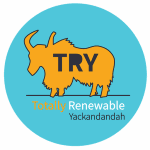
West End Resilience recognises the work done around renewable energy in the Castlemaine community by many individuals and groups, and wants to build on that to understand how it can be applied for the benefit of everyone in the community. Our neighbourhood energy group held a great session about Community Energy last Monday night with over 30 people Zooming in for a Q&A with speakers Alan Pears and James Jenkins. Not everyone could make it, so here’s a link to the recording… https://bit.ly/3Cqlvks (starts at 00.03.25)
And some other Neighbourhood energy links…If you’d like to know more about the Yackandandah experience here’s a link to their web site: Totally Renewable Yackandandah: Community Energy Pioneers! https://totallyrenewableyack.org.au/
Alan Pears’ Energy efficiency talks: Healesville CoRE https://www.healesvillecore.org.au/making-our-homes-more-comfortable-while-saving-money-and-the-environment/
Southern Otways Sustainable- https://www.southernotwayssustainable.com.au/post/fisherman-s-co-op-energy-efficiency-win
Alan Pears: https://youtu.be/jF1By1X8Z3I
Community Panel Q and A: https://youtu.be/L42m0rvMhQQ
Energy Upgrade Finance – Victorian State Government- https://www.energy.vic.gov.au/energy-efficiency/environmental-upgrade-agreements
Latest from Vic Govt re supporting rural communities for resilience: Victoria to subsidise “energy resilient” microgrids for bushfire hit towns | One Step Off The Grid
Solar Vic info for renters to encourage the install of PV – Information for renters | Solar Victoria
With thanks to Ilka White for gathering together this information.
10. Deliberative Engagement
There’s a growing group of Mount Alexander Shire community members and representatives from community organisations or groups who have been exploring the concept of, and developing expertise in, deliberative engagement. During the past six years this has involved learning about Voices for Indi’s model of Kitchen Table Conversations (KTC) piloting KTC’s in our neighbourhoods, engaging in Citizens Assemblies , community panels, and democratic renewal, as well as various types of group process capacity building. More recently we have been part of a short term project coordinated by Central Primary care Partnership (CVPCP) in building resilience in the face of climate change and had the opportunity to attend Deliberative Engagement training with Mosaic Lab.
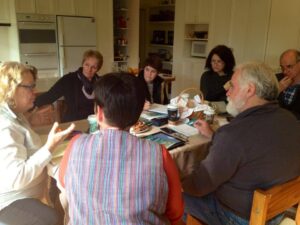
We recognize that neighbourhood networks, trusted relationships with community influencers, diverse expertise on climate change and deliberative engagement, dedication and intelligent action already reside in the community and wish to build on that. We are currently exploring a diversity of smaller scale and lower cost ways of deliberative engagement that ensure a broader engagement and a more random representation in decision making within our community using structures and expertise already available within our community.
Our group is also considering piloting a deliberative engagement project on the complex challenge of climate change and are inviting Mount Alexander Shire Council (MASC) to be part of it. We are considering designing KTC’s with one or more neighbourhood networks starting with the West End Resilience Network. The KTC’s will focus on the theme of climate change, using language and approaches to pitch the conversation appropriately to these networks including their members who are not usually reached, or engaged with, via more formal consultation processes.
If you’re interested to be part of, or learn more about this initiative, contact Carolyn Neilson: projects2@centralvicpcp.com.au
Photo: Voices for Indi website
11. Gather- Castlemaine Commons & a Solidarity Network
When: Sunday 5th December 1-4pm
Where: Theatre Royal, Castlemaine, on Dja Dja Wurrung Country
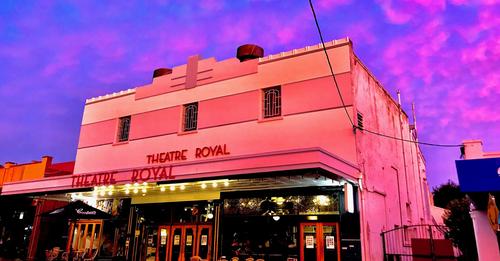
It’s been quite a time hasn’t it friends? There are so many feelings, so much to reflect on and lots to share. The Castlemaine Commons Collective invites you to GATHER together for an afternoon at the Theatre Royal.
We invite reflections about where we have been and where we might be going. We are in the same storm, but not the same boat. We imagine an open conversation as our responses to covid shift again. How do we use the lessons from the pandemic to stay connected and continue to build community as we face more challenges, such as our rapidly changing climate, together?
We’ll be hosting two discussions with a revolving panel and open mic approach (so come ready to share!) and then spending some time mingling, connecting and gathering. We will also share music and some snippets from recent interviews Castlemaine Commons have been doing with locals reflecting on care and community organising. We know that not everyone in our community is able to gather in person at the moment and so we will accommodate those who want to participate digitally via zoom.
This ‘event’ is a merging of ideas from Castlemaine Commons and the Solidarity Group proposed by Anitra Nelson.
Please indicate if you would like to join on zoom when selecting your ticket type.
Facebook event page https://fb.me/e/QSWYaqtA
Trybooking link for tickets https://www.trybooking.com/events/landing?eid=829363&
With thanks to Alex Kelly for preparing this information.
12. Benefit Concert for Central Vic wildlife Hospital
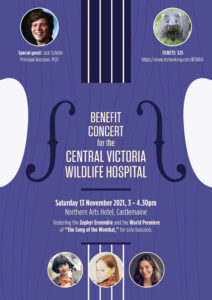
When: Saturday 13 November 2021, 3 – 4.30pm
Where: Northern Arts Hotel, Barker Street, Castlemaine
Tickets: $25 https://www.trybooking.com/BTWKA
13. New Economy Network Conference
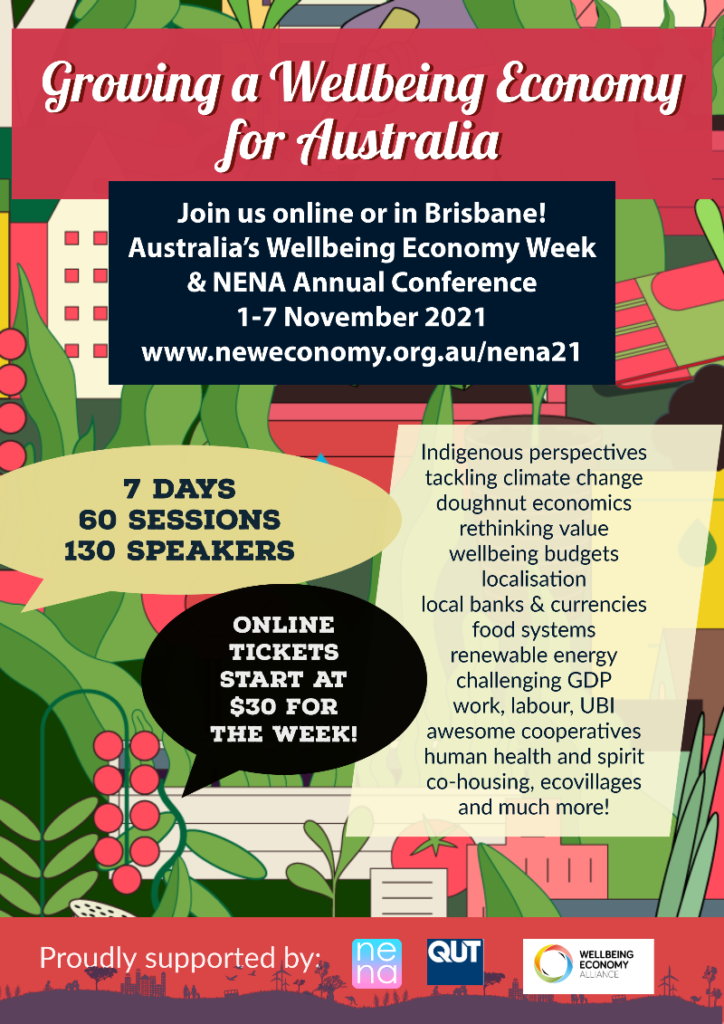
Join the Australian new economy network and our guest speakers from around the world, as we explore the meaning of ‘wellbeing’ and discuss ways that we can reshape our economic system, in a rapidly changing world. NENA Conferences offer a great space to share stories, experiments, project updates and research about how to build a new economy system that supports people and planet.
This year’s conference has more than 70 sessions, over 100 speakers, and will explore the most pressing issues of our time.
With many excellent proposals and speakers, NENA’s Annual 3 day conference has turned into “2021 Wellbeing Economy Week”. Check out the program to see the events that start on Monday 1 November and go through to the ‘official’ conference dates: 5-7 November 2021.
Register for the conference here
Questions? Please email us: nena@neweconomy.org.au
14. Local Law for Weed Control in Mount Alexander Shire

Wheel cactus (Opuntia robusta), from Mexico, is one of a number of introduced plants. Uncontrolled infestations of this cactus prevent growth of our indigenous plants, which causes an imbalance in the native ecosystem and lack of food source for native insects, birds etc.
Mount Alexander Shire Council has recently released a revised version of its relevant local law, which includes a new bylaw specific to the Control of Noxious Weeds (Clause 19). This new law makes it easier for Bylaw Officers to impose landholders noxious weed management obligations and will help reduce the spread of weeds. If you need any help and/or advice on how to control your wheel cactus infestation, contact the Tarrangower Cactus Control
Group- https://cactuswarriors.org/
Article first published in October 2021 edition, North Central Chat (North Central CMA)
15. New hope in central Victoria for endangered Eltham Copper Butterfly
The nationally endangered Eltham copper butterfly (Paralucia pyrodiscus lucida) represents one of the most fascinating stories both due to its co-dependency in nature and how the community have rallied for this species. This is a rare, good news story within the extinction crisis across Australia of how we can save species, with enough care and resources anything is possible.
It is a story of lost and found and lost and found again. It was formally described in 1951 having been collected from a number of sites around Eltham in 1923-56. Subsequent lack of records over the next 37 years combined with housing development clearing them from areas where they once thrived (Tallarook, Murtoa, Dimboola, Keilor, Broadmeadows and Yarrambat) resulted in the belief that they had become extinct. They were rediscovered at Eltham in 1987 on a property about to be subdivided. Community campaigning for this tiny insect resulted in eight hectares around Eltham/Greensborough being purchased and protected.
The 1987 discovery also triggered and funded a statewide search, and nine colonies were discovered in 1988, including in two new regions: Castlemaine and
Kiata/Salisbury area. Finding where a rare species lives is the first step in conserving it,but protecting it from threats is the next. Sadly, since 1988 three known populations were lost through housing development (Montorency, Lower Eltham Hills)and from grazing/weed invasion (Salisbury). An unknown number have been lost from areas where they had yet to be discovered. However, bursts of effort over the decades have led to the discovery of new populations, mostly in North Central Victoria.
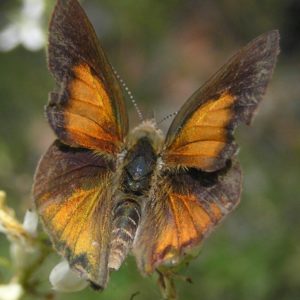
In 2011, a 3000 ha search resulted in eight new populations found around Bendigo and Castlemaine. All new populations are very localised within a larger area of what appears to be suitable to the human eye, but the butterfly only occurs in 3-25% of habitat. Numbers of butterflies within these areas are also very small, with populations around 50, but peppered through a larger area. Currently, what makes good habitat for a truly interconnected species is very complex.
The Eltham copper butterfly, like many of the blue butterfly family, has a fascinating ecological dependency with two species– a Notoncus ant species and the sole larval food plant, sweet bursaria (Bursaria spinosa). Not to mention an unknown array of environmental factors including food for the ants, relationships with predators, aspect, soil type etc. It is a small attractive butterfly with bright copper colouring on the tops of its wings and lives in dry open woodlands. The relationship works like this. The adult Eltham copper butterflies lay their eggs on or at the base of sweet bursaria plants. The eggs hatch and the larvae make their way to the ant nest where they are tended and guarded by Notoncus ants. This amazing service is achieved through a mixture of trickery and treats.
Local ecologist Elaine Bayes is one of the leading ecologists championing the future survival of the eltham copper butterfly in Northern Victoria. Elaine has conducted numerous surveys for the butterfly and its preferred habitat over the past decade, along with her colleague ecologist Karl Just and a team of citizen scientists, uncovering new populations along the way. Elaine recently obtained funding through the Victorian Government’s Biodiversity Onground Action Program to map and monitor current known populations and conduct further surveys for suitable habitat across central and western Victoria, and is excited about the chance of finding further populations of the special butterfly. “We have the opportunity to conduct surveys in locations that we have not previously surveyed, but we know have great habitat potential,” she said. “The next six months will see our team survey locations around Castlemaine, Chewton and Kiata, with the hope of discovering new populations, which is very exciting and vital to the survival of this endangered species.”
Sightings of this elusive butterfly can be reported on the new and amazing Butterfly Australia App: https://apps.apple.com/au/app/butterflies-australia/id1452753283
Article first published by Connecting Country: https://connectingcountry.org.au/
16. New Name for Creek
Hepburn Shire Council is working with project partners, Mount Alexander Shire Council, North Central Catchment Management Authority and Dja Dja Wurrung Clans Aboriginal Corporation (DJARRA), on the proposed renaming of Jim Crow Creek to Larni Barramal Yaluk.
Larni Barramal Yaluk means ‘Home or habitat of the Emu Creek’. The renaming of Jim Crow Creek is being proposed in recognition of Aboriginal heritage and the reinstatement of Dja Dja Wurrung language into the landscape, and the removal of a name that is offensive and derogatory.
“The history of the term ‘Jim Crow’ is rooted in racial segregation and racism. We want to learn, acknowledge and move forward together. By reinstating a name that reconnects our community with the Dja Dja Wurrung culture and language that spans many thousands of years, we are setting the standard for how we can support the Dja Dja Wurrung Peoples,” said Hepburn Shire Councillor Lesley Hewitt.
Rodney Carter, CEO at DJAARA, said the proposed renaming is really positive because it is putting language back into the landscape, and therefore puts People back into the landscape. “Naming places in our language opens up conversations so when people say that word, it is talking to Country. You create a degree of fondness and care of a place,” said Mr Carter.
The name “Jim Crow Creek” will be reserved in the state’s geographic names register as a historic name and will remain a part of the region’s history. There are strict protocols that govern the renaming outlined in the Naming rules for places in Victoria – statutory requirement for naming roads, features and localities 2016. The engagement phase of the project will be held 30 September to 12 November 2021.
For information on the renaming process, frequently asked questions and ways to provide feedback, visit https://participate.hepburn.vic.gov.au
17. Bird of the month: Kestrel
Bird of the month is a partnership between Connecting Country and BirdLife Castlemaine District. Thanks to Jane Rusden from BirdLife Castlemaine District with assistance from Damian Kelly and photos by Ash Vigus.
Australian Kestrel (Falco cenchroides)
A member of the Falco genus which includes Peregrines and Hobbies, Kestrels are widespread across the world, with 13 species recognised. A few overseas species migrate with the seasons, but most are non-migratory, although they will move about depending on food availability. Their diet includes small birds, mice, reptiles, locusts and grasshoppers along with some other insects, spiders and other terrestrial invertebrates. They will readily move to areas of abundance during mouse and locust plagues. Within Australia, many areas have resident pairs. Juveniles spread widely after fledging and may move long distances.
Australia has one species – the Australian or Nankeen Kestrel. It can be found all over the Australian mainland and on some outlying islands including Tasmania, most Bass Straight islands as well as Christmas, Norfolk and Lord Howe islands. It has occasionally been recorded as a non-breeding visitor to Papua New Guinea, the Torres Strait islands, New Zealand and Java. It is likely that they have expanded in both population and distribution with the clearing of forests for farmland, as they prefer open country. They have also readily adapted to taking the introduced House Mouse as well as the Common Starling, which often comprise a significant part of their diet.
It is the smallest Australian Falcon with a length of 30-35 cm and a weight range of 165 g for males to 185 g for females. They are great fliers, soaring and hovering with ease. Quite spectacular to watch.
Generally, breeding occurs between August to December. Australian Kestrels are quite adaptable and will utilise tree hollows, cliffs, old nests of other birds, nest boxes and even the broken tops of anthills. There are also records of them using sinkholes in the ground and mine shafts. They are known to use the nests of White-winged Chough, Australian Magpie, Whistling Kite, crows and ravens and even the top of Chestnut-crowned Babbler nests. Certainly very adaptable!
Clutches of eggs range from 1 to 6, but usually 2-3. Most of the incubation is done by the female with the male feeding her. Upon hatching the female generally feeds the young, often with food brought to the nest for her by the male. There are some remarkable records of fostering, with young kestrels being reared by Black-breasted Buzzards and even a Black Falcon feeding young kestrels at the nest.
To hear the call of an Australian Kestrel, please – click here
Posted by Connecting Country: https://connectingcountry.org.au/
18. Building anti-gold mining campaigns
When: Sunday November 14th, 2-4pm , via zoom
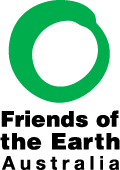
With a growing number of local groups opposing gold exploration and mining, Friends of the Earth is organising a 2 hour get together to find ways we can support each other in our campaigns. Also to share our ideas about what makes for a successful campaign.
Local anti gold groups are invited to attend. Each group will be asked to give a brief ‘elevator pitch’ on their campaign:
- Where they are/ who they are
- What company or companies are they up against? (and what stage is the project up to)
- What tactics are they using (eg opposing individual exploration license applications, influencing local council, using petitions, mobilising farmers or local businesses, etc)
- Any help they would like from other groups.
The aim is to keep each presentation to 5 minutes, then a short (10 min) presentation from a group that has won against a gold mine proposal. Followed by time for chats. Contact details will be shared with all the groups who attend, so people can then follow up directly with other groups that have shared interests.
Share this invite with other groups who are fighting gold exploration and mining. Think about whether you would like to nominate your campaign as an example of a success story that can be discussed at the meeting.
For more information or if you’d like to attend contact Cam Walker: Cam.walker@foe.org.au
19. New Community Visions & Council Plans
All local governments have been preparing their ten year Community Visions and four year Council plans. These are now public documents. Here’s a couple of samples from Mt Alexander and Hepburn Shires.
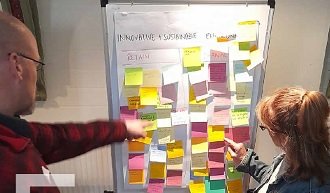
Mt Alexander’s new ten-year Community Vision 2021-2031:
“In 2031, our community is connected to each other, and comes together to build and celebrate an inclusive, creative shire. We are a healthy community that values the natural beauty of the Djaara Country we live on. We know that preserving our natural environment means living sustainably and caring for country. We are protecting our shire from the threat of climate change by working together at the local level. We are a welcoming community where everybody has access to services and supports, and opportunities for housing, education, employment and creative and social pursuits. We are known as a vibrant place which draws upon its creative spirit and shared heritage. We are building a place where everyone can enjoy the beauty, history and friendliness of the shire”.
The Community Vision and Council Plan 2021-2025 are designed to complement each other, and work together to set the strategic direction and priorities of Mount Alexander Shire Council in the coming years. The plan has 3 pillars: A healthy, connected and inclusive community; An environment for people and nature; A resilient and growing local economy.
For more information: https://www.mountalexander.vic.gov.au/Page/Page.aspx?Page_Id=4187&nc=2
Hepburn Shire’s Community Vision and Council Plan:
Hepburn Shire’s Vision statement- “An inclusive rural community located in Dja Dja Wurrung Country where all people are valued, partnerships are fostered, environment is protected, diversity supported and innovation embraced”.
The Council Plan 2021-2025 describes how Council will strive towards the vision during the four-year term, where to focus efforts, priority actions and how to measure progress. This includes five key focus areas of:
- A resilient, sustainable and protected environment.
- A healthy, supported and empowered community.
- Embracing our past and planning for the future.
- Diverse economy and opportunities.
- A dynamic and responsive Council.
You can read the full Council Plan, Community Vision and Municipal Public Health and Wellbeing Plan on Hepburn Shire’s website.
20. Saltgrass Podcast Award
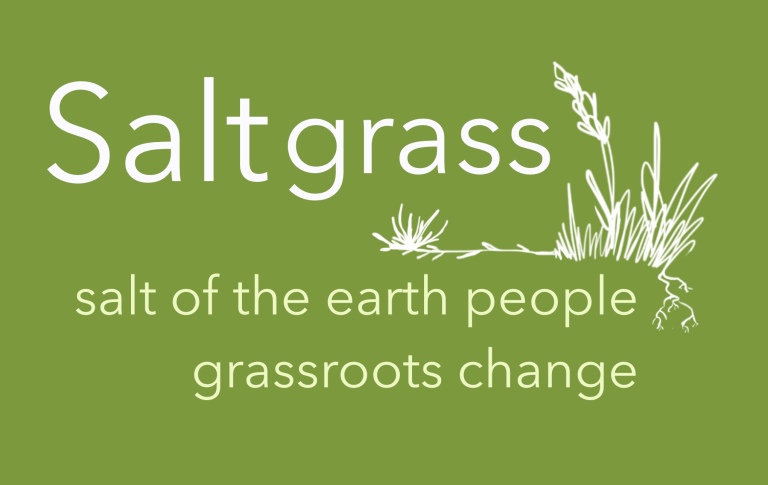
Saltgrass Podcast announced as a finalist for World’s Top Nature Media Competition – Jackson Wild Media Awards.
Created by Allie Hanly on Djaara Country in Castlemaine, Central Victoria, Saltgrass is a fortnightly radio show and podcast spotlighting what individuals are doing to address the climate crisis within their local community. Saltgrass celebrates grassroots, bioregional change-makers – from farmers to artists to activists – engaging with the issue of climate change in their own unique and impactful ways. Currently in its fourth season, Saltgrass recently appeared in The New York Times as one of the top five podcasts to ‘help you understand the problems and potential solutions’ to a Changing Planet.
Nature film’s equivalent to the Oscars, the Jackson Wild Media Awards celebrate excellence and innovation in nature, science, and conservation storytelling. For the first time in its 30 year history, a podcast category has been added to the 2021 awards. “The judges selected an incredible slate of inspiring finalists with powerful messaging… These richly woven stories reflect diverse perspectives from around the planet, and are deeply personal and purpose-driven,” said Lisa Samford, Executive Director of Jackson Wild.
There are two other finalists in the Podcast category – Jane Goodall’s ‘Hopecast’, and ‘Guardians of the River’, a series produced by The National Geographic. Saltgrass host Allie Hanly is “incredibly humbled to be in such esteemed company.”
The show is produced for award-winning community radio station MAINfm, and is funded by The Community Broadcasting Foundation. “It is a testament to the amazing, active and passionate community we have here on Djaara Country in Central Victoria. There are so many incredible individuals and groups working on so many different levels of climate change action. All I have to do is talk to them about what they are doing! We’ve produced over 60 episodes and there are so many stories still left to tell.”
Winners announced during the Jackson Wild Media Awards Ceremony, September 30, 2021. Saltgrass is available for listening on your preferred podcasting app or online at www.www.saltgrasspodcast.com.
21. Free green waste for Hepburn Shire residents
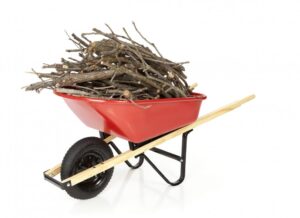
Throughout November Hepburn Shire Council offers residents free green waste disposal at our three transfer stations (Trentham, Creswick and Daylesford) to help residents prepare properties for the fire danger period. Ensure that green waste is free of noxious weeds and is separated from other items. Visitors to the transfer stations must comply with COVID safety requirements.
For details on transfer station opening hours visit the website.
22. New Hepburn Shire local laws/guidelines for salvaging, firewood collection & nature strip planting
Hepburn Shire Council recently endorsed new guidelines around nature strip planting, firewood collection and salvaging materials transfer stations. Council formed three separate community reference groups and held thre facilitated sessions for each group to understand the views of the community. Mayor, Cr Lesley Hewitt, said that the guidelines were drafted by each of the reference groups which comprised community members, Councillors and Council staff.
“The groups have done a fantastic job in working together with Council to develop these guidelines. It was important that we heard from the community while also ensuring that the guidelines comply with relevant legislation,” said Cr Hewitt. “We believe this balance has been struck and the guidelines clearly outline the rights and responsibilities for community members”.
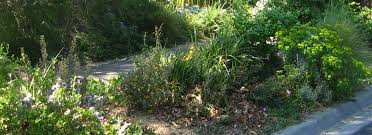
The guidelines relating to planting on nature strips has established a clear set of rules which provide two main options for nature strip (verge planting) for residential and rural nature strips. Planting options range from natives through to edible gardens. This guideline is not retrospective, but relates to vegetation planted from now onwards. The salvaging guidelines focus on improving the existing accessibility to Council’s waste Transfer station goods. Focusing on reusing and repurposing materials dropped to the transfer stations and how best to do this. The firewood collection guidelines that have been developed to protect biodiversity, community safety and allow for the collection of firewood in Council designated areas.
Tip shops are open
If you love a bargain you’ll love our tip shops. Hepburn Shire operates tip shops at each Transfer Stations in Creswick, Daylesford and Trentham. Our tip shops sell used, recycled and second hand products which have been salvaged rather than going to landfill. Keep an eye out for vintage classics and unmissable bargains. Visit our website for opening hours and more.
The Orchard Keepers are keen to build stronger local relationships and increase the local distribution of our fruit. In terms of the CSA we will be offering fewer shares than Ant had – bringing the number down to 80 – mostly to ensure there is enough fruit for the weekly Sunday morning Pick Your Own we’ll be trialling this season (yum!) We’re also working to bring our membership to as close to the farm as possible. This means we will no longer be offering CSA shares in Melbourne – but we’ll still be at the Coburg Farmers Market.
At the time of writing we have 20 CSA shares left!
How does the CSA work?
CSAs vary all around the world, but essentially we are seeking to break with more traditional systems of sales and distribution and build closer relationships between customers and farmers. Customers sign up by buying an upfront share in the coming harvest. This means that you are joining a community that can collectively share risk, as opposed to all of that being on the farmer alone. This means that you are in with us and get to share in adversity as well as abundance.
We invite members to pay an amount within a reasonable range for a share – in exchange you get a weekly fruit box over the season. Our season averages 22 weeks and includes cherries, apricots, nectarines, peaches, plums, apples and pears – amongst which there are almost 100 varieties! We offer 3kg and 4.5kg boxes at a suggested price of $500 per season for 3kg box (which is around $7.50 per kilo of fruit) and $700 per season for a 4.5kg box (which is $7 per kilo). We invite members to pay what they can in a range from $420 – $700. Those that can afford to pay more will be supporting others to pay less while still ensuring that the Orchard Keepers are also sustained in their stewardship of the orchard.
We are aiming to have 80 CSA members this season as local as possible to the farm and will be offering collection points at the Farm Shop in Harcourt as well as in Castlemaine and Maldon. If you would like to learn more see the Orchard Keepers website here and if you are ready to SIGN UP FOR A CSA SHARE please click here!
Alex, Yoann, Terry & Ingrid – The Orchard Keepers collective
24. New Edition- Wildlife of the Box Ironbark Country

The second edition of this book is expected in October.The new edition is well deserving of its tag line … A comprehensive overview of the ecologically significant Box–Ironbark habitats and their wildlife.
Victoria’s Box–Ironbark region is one of the most important areas of animal diversity and significance in southern Australia. The forests and woodlands of this region provide critical habitat for a diverse array of woodland-dependent animals, including many threatened and declining species such as the Squirrel Glider, Brush-tailed Phascogale, Regent Honeyeater, Swift Parrot, Pink-tailed Worm-Lizard, Woodland Blind Snake, Tree Goanna and Bibron’s Toadlet.
Wildlife of the Box–Ironbark Country gives a comprehensive overview of the ecology of the Box–Ironbark habitats and their wildlife, and how climate change is having a major influence. This extensively revised second edition covers all of the mammals, birds, reptiles and frogs that occur in the region, with a brief description of their distribution, status, ecology and identification, together with a detailed distribution map and superb colour photograph for each species. The book includes a ‘Where to watch’ section, featuring a selection of national parks, state parks and nature conservation reserves where people can experience the ecosystem and its wildlife for themselves. This book is intended for land managers, conservation and wildlife workers, fauna consultants, landholders, teachers, students, naturalists and all those interested in learning about and appreciating the wildlife of this fascinating and endangered ecosystem.
The book will be available from all good bookstores in October 2021 – $49.99. Further details here: publish.csiro.au/book/7945
About the author
Chris Tzaros is uniquely placed to write about the fauna of Victoria’s Box–Ironbark country. Brought up near Bendigo, he has had a passionate interest in wildlife since childhood. Chris has 25 years’ experience working on wildlife research and conservation projects, largely focused on threatened woodland birds, for both government and non-government environmental and conservation organisations. He is an award-winning wildlife photographer and has produced the majority of the photos in this book. Chris is currently an independent wildlife ecologist and nature photographer based in north-east Victoria but enjoys working among nature right around Australia.
25. The Wombat Post
The Wombat Post is a weekly online publication covering local news for Daylesford and Hepburn Springs and is published every Friday afternoon.
Submissions: The Wombat Post encourages community submissions of news, events, stories, photos and business and community listings. If you are interested in submitting have a look here.
Facebook Updates: If you want Facebook news updates during the week, like us on the Wombat Post Facebook page
The Wombat Post is a not for profit, community run news service for Daylesford and Hepburn Springs.
29. Resourceful Hepburn- Survey Responses
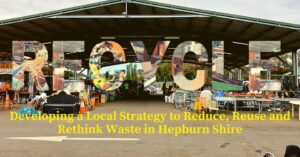
Here’s a summary of community responses to Resourceful Hepburn’s (RH) Survey:
RH should concentrate on Repair, Reuse and Repurpose, with Recycle a lower priority. Enhancement of Repair, Reuse and Repurpose should be via tip shop and repair cafe enterprises. Enhancement of Recycle should be via education. The way ahead should be easy and simple, and it should involve networking (including with the shire’s artistic community).
In terms of future resource recovery priorities in Hepburn Shire, responses showed that Reuse is the highest priority, then Repair, then Repurpose, then Recycle. Respondents indicated overwhelmingly that a Community Resource Recovery Enterprise in Hepburn Shire would be an improvement compared with the current situation.
For more detailed survey results : https://www.facebook.com/groups/321682892606359/
30. Common Times
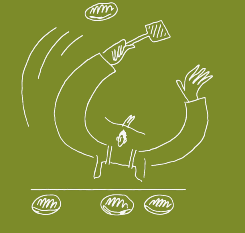
For more information: Rhea Favero, Community Connector,
31. A new species for the Wombat Forest
The Mountain Skink, Liopholis montana, is a newly discovered species. In December 2020, Monash University reptile researcher, Jules Farquhar, with his companions Wyn Russell and Nicholas Gale, discovered several individuals of Liopholis montana in the Wombat State Forest. They observed six adult and seven juvenile specimens active or basking on low rocks and logs.
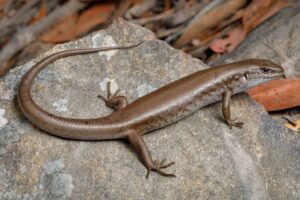
Their recently published paper, “A significant range extension for the mountain skink Liopholis montana (Donnellan, Hutchinson, Dempsey & Osborne, 2002) on the Western
Uplands of Victoria”, details the detection of a population of Mountain Skinks along the Lerderderg River, west of Blackwood. This is a very exciting sighting as the known
range for the Mountain Skink extended from the Australian Capital Territory to southern New South Wales to Victoria along the Great Dividing Range, with the western limit of the range defined by a record at the Upper Yarra Dam. The Kilmore gap, a broad and low saddle in the Great Dividing Range between Wallan and Kilmore, separates the
Western Highlands from the more mountainous Eastern Highlands. This record is the first for this species west of the Kilmore gap.
The Mountain Skink was only described in 2002 and has a scattered distribution, and is largely found in rocky habitats in subalpine woodlands or open dry forests. It is a medium sized, smooth scaled skink native to southeast Australia with a snout to vent length up to 111 mm. The basic colour is grey-brown and most skinks have a reddish brown upper surface. There is also a patterned morph, which is not as common. The juveniles have white spots alternating with dark stripes, which fade as they mature. They construct deep burrow networks beneath rocks and live in colonies, which is uncommon in the reptile world and appear to form stable pair bonds. The females give birth to four young. Their diet is omnivorous and includes seasonal fruits.
Threats: cats and foxes are major predators of reptiles and Mountain Skinks are particularly vulnerable due to the predictability of their emergence from permanent burrows. Motion sensing cameras deployed south west of Blackwood have detected a large number of foxes in the vicinity of the second location, which could constitute a significant threat to their survival. Planned burns may also present a threat as they can significantly reduce the amount of woody debris and fallen logs. The authors of the range extension publication noted that “At the L. montana site, coarse woody debris was abundant and we observed many L. montana basking on logs, sheltering within log crevices, or retreating to the surface of litter beneath logs.” Planned burns can also cause a change in vegetation structure and may produce thicker regrowth that could shade basking sites. Road and track construction and maintenance that displace rocks as well as rock stacking threatens the refuge sites of these skinks.
This is an extract from the article published in September edition Wombat Forest Care, By Gayle Osborne. https://www.wombatforestcare.org.au/
Photo: Jules Farquhar
32. Food for Thought
32.1 The dawn chorus- in Dumbo Feather
We don’t always see the birds. But there is a mystical element to closing our eyes and drenching our ears to birdsong – we feel it. It is a three-dimensional experience: some birds are high up in the branches, others down low; some close, others far; and certainly, the vibrations of nature as we sit amid it. Studies have shown again and again that humans receive restorative benefits when connecting with nature. Whether it’s going outside on a forest walk or listening to a recorded nature soundscape, birdsongs can relax us physically and stimulate us cognitively.
Read Thanh-Thy Tiffany Tran’s article on the majesty of birdsong.
32.2 Soil City Co-operative Farms wants to put together a library of land use agreements that their landholders and farmers can look through to ideas for what could be included in their future landholder/coop land use agreements. If you know of any interesting arrangements, please email through the details here!
32.3 Alternatives and Futures: Cultures, Practices, Activism and Utopias. This new Palgrave Macmillan series is now up and running with three publications launching in 2021. And we invite you to pitch any ideas you have for a manuscript that might be a good fit in this series.
|
This week we talked with Prof. Pam Nilan about fascist utopias, youthful fantasy and her book Young People & The Far-Right.
www.3cr.org.au
|
|
Movements such as degrowth, Occupy, solidarity economies, permaculture, low impact living and Via Campesina variously address key issues of the contemporary era such as inequalities of wealth and income, environmental crises, and achieving sustainable cities and production.
www.palgrave.com
|
The report includes data from the largest ever national survey on climate and health. The survey was completed by 875 health professionals across Australia, including doctors, nurses, public health professionals and more. It found:
- Climate change is already having a moderate to great impact on public health in Australia, agreed 72% of respondents
- Climate change is a serious problem requiring immediate action, agreed 86% of respondents
- Climate change is already disrupting staff provision and damaging healthcare infrastructure, agreed 83% of respondents
- Extreme weather or a natural disaster had affected 55% of respondents’ workplaces in the previous 12 months
- The most common climate-related health conditions seen by respondents were heat stress, mental distress related to climate change, respiratory illnesses, bodily harm from bushfires, and pollen-related allergies. Respondents expect climate-related presentations to increase over the next decade.
According to this report, health professionals say they are looking for information, training and resources to respond to climate change from their professional associations and health departments. I am scoping interest in training developed and delivered by Climate and Health Alliance for the health professionals at our local medical clinics.
32.5 On the podcast: Hugh Mackay on kindness
Hugh Mackay joins us to share the insights, research and thinking behind his latest book The Kindness Revolution – as recorded from the Small Giants Academy virtual conversation event in July. Listen to episode
32.6 LOCAL ACTION AND SYSTEMIC CHANGE
In the pursuit of never-ending growth and profits, the corporate-led global economy is putting all life on earth at risk. When we take action to localize our economies and strengthen our communities, we are helping to bring about a systemic shift in direction – towards cultural and biological diversity, social justice, genuine democracy, and our own health and happiness. It’s time to bring our economies back home, to return to a human scale, to localize.
32.7 Making Relatives by Diane Wilson
“To me, the prickly ash hill was the equivalent of unbridled colonization forces at work, creating a new narrative that has displaced this land’s original story.”
We live in a time when human impact is shifting ecologies in unprecedented ways: colonization, industrialization, and urban development have reshaped landscapes, displacing and relocating populations of plants and animals. How do the changing identities of our landscapes intersect with our own shifting identities as caretakers and stewards?
Diane Wilson, a Dakota grandmother, asks what it means to be a good relative to the land as she endeavors to restore balance between the native and invasive plants around her home. As she attempts to make a relationship with the most aggressive species, she acknowledges a deep grief for what her people and the land have lost, as well as a desire to nurture reconnection and carry forward an ancient, healing relationship.
This essay is the second in our series of excerpts from Kinship: Belonging in a World of Relations—a five-volume collection edited by Gavin Van Horn, Robin Wall Kimmerer, and John Hausdoerffer. READ ESSAY

![[ Random Image ]](https://leanganook.org/images/image_11.jpeg)



